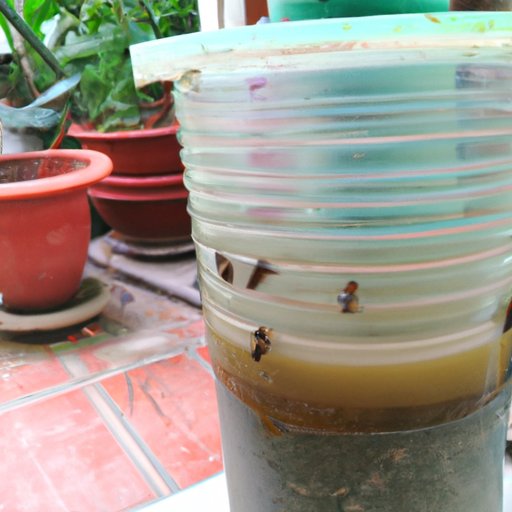Introduction
Fruit flies are a pervasive household pest that can be challenging to control. These tiny insects are a common problem in homes, kitchens, and restaurants and can quickly become a nuisance. They have a short lifespan but can reproduce quickly, causing an infestation to spiral out of control in just a few days. To tackle the problem, a homeowner needs to know how to catch fruit flies effectively. The importance of addressing the issue is paramount to maintaining a clean and healthy environment.
DIY fruit fly traps
The easiest way to catch fruit flies is by using a DIY trap. These traps are easy to make, require only a few materials, and can be set up in minutes. To make a trap, one needs a container, liquid bait, and a covering material like plastic wrap. The bait can be anything that lures fruit flies – apple cider vinegar, beer, wine, or fruit juices.
Step-by-step instructions:
- Choose a container for the trap – a jar, a mug, or a bottle.
- Pour the liquid bait into the container – it should fill one-third of the container.
- Wrap the container with plastic wrap, leaving a small opening.
- Poke several holes in the plastic wrap with a toothpick.
The traps should be set up in the infected areas of the house – the kitchen, garbage disposal area, or indoors near the compost bin or the garbage bin. The traps provide a passive and safe way to eliminate fruit flies, making them an excellent option to control the infestation.
Chemical-free methods to catch fruit flies
Natural methods, chemical-free, are other effective ways to catch fruit flies. Two such methods are vinegar and dish soap traps and basil plants.
The vinegar and dish soap trap is easy to set up. One needs a container, apple cider vinegar, dish soap, and plastic wrap. The bait’s strong scent attracts the fruit flies to the surface, and the dish soap traps them.
Basil plants emit a strong smell that repels fruit flies. By keeping fresh basil plants in the kitchen or near infected areas, one can prevent the fruit fly infestation from spreading.
Advantages of using natural methods:
- Safe and non-toxic for humans and pets
- Effective in controlling fruit flies
- Economical and easy to set-up
Finding and eliminating attractants
When tackling the fruit fly infestation, it is essential to locate and remove the attractants. The attractants can be any food waste, garbage, or compost that provides food and breeding grounds for the fruit flies. Disposing of the waste regularly and keeping the environment clean is crucial in preventing a fruit fly outbreak.
Common attractants of fruit flies include:
- Overripe fruits and vegetables
- Spoiled and open food containers
- Dirty dishes and empty cans and bottles
- Moist places and spills
Eliminating the attractants and maintaining cleanliness is crucial in preventing a re-infestation. It is essential to identify the source and address it accordingly to eliminate the infestation.
Creating an ecosystem to trap fruit flies
Carnivorous plants like sundews are natural predators of fruit flies. They trap the insects using sticky leaves and digest them for their nutritional needs. Creating an ecosystem of sundews is an innovative way to control the fruit fly infestation.
To set up an ecosystem of sundews:
- Purchase a few sundew plants from a garden store.
- Place the plants in a pot or a terrarium.
- Water the plants using distilled water or rainwater, so the soil does not have mineral content.
- Place the pot or terrarium near an infected area or fruit fly attractant.
Precautions:
- Keep the plants out of reach from children and pets
- Do not use tap water on the plants as they have high mineral content
- Do not overfeed the plants as it can harm the plant’s growth
Using fruit fly baits
Fruit fly baits are an innovative way to lure and trap fruit flies. They work by attracting the fruit flies with an irresistible smell and then trapping them. Baits can be overripe fruits or fruit juices that produce strong scents.
One can use the baits by placing them near the infected areas or fruit fly attractants. Using baits and traps together can provide an excellent way to control the infestation and reduce its spread.
Advantages of using bait and traps together:
- Effective in controlling fruit flies
- Uses natural methods
- Economical option
Overall sanitation
Maintaining cleanliness is crucial in controlling fruit flies. Regularly cleaning and disinfecting the kitchen, countertops, and floors can help eliminate the fruit fly problem. Keeping the area dry, free from excess moisture and spills, can prevent further infestation.
To maintain overall sanitation:
- Store fruits and vegetables in airtight containers
- Dispose of food waste and garbage regularly
- Clean the dishes and utensils immediately after use
- Wipe the kitchen countertops and floors regularly
Preventing fruit fly infestations
Preventing fruit fly infestations is essential in maintaining a healthy and clean environment. Simple precautions like taking care of the storage of fruits and vegetables can reduce the risk of infestations. Proper storage of fruits and vegetables in airtight containers can help prevent these pests’ breeding and reduce spoilage.
Proactive measures like regular cleaning, using natural methods, and setting up traps and ecosystems can prevent the fruit fly problem from becoming a nuisance.
Conclusion
Fruit flies are a common household issue, and they can be challenging to control. Learning how to catch fruit flies effectively can prevent the issue from becoming a nuisance. Natural methods like DIY traps, baits, and ecosystems using carnivorous plants like sundews can provide an innovative way to control the infestation. Finding and eliminating attractants, maintaining cleanliness, and taking proactive measures can prevent the fruit fly problem from spreading.
